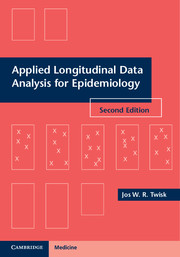Book contents
- Frontmatter
- Contents
- Preface
- Acknowledgements
- 1 Introduction
- 2 Study design
- 3 Continuous outcome variables
- 4 Continuous outcome variables – relationships with other variables
- 5 The modeling of time
- 6 Other possibilities for modeling longitudinal data
- 7 Dichotomous outcome variables
- 8 Categorical and “count” outcome variables
- 9 Analysis of experimental studies
- 10 Missing data in longitudinal studies
- 11 Sample size calculations
- 12 Software for longitudinal data analysis
- 13 One step further
- References
- Index
11 - Sample size calculations
Published online by Cambridge University Press: 05 May 2013
- Frontmatter
- Contents
- Preface
- Acknowledgements
- 1 Introduction
- 2 Study design
- 3 Continuous outcome variables
- 4 Continuous outcome variables – relationships with other variables
- 5 The modeling of time
- 6 Other possibilities for modeling longitudinal data
- 7 Dichotomous outcome variables
- 8 Categorical and “count” outcome variables
- 9 Analysis of experimental studies
- 10 Missing data in longitudinal studies
- 11 Sample size calculations
- 12 Software for longitudinal data analysis
- 13 One step further
- References
- Index
Summary
Introduction
Before performing a longitudinal (experimental) study, it is “necessary” to calculate the number of subjects needed to ensure that a certain predefined effect will be significant. Sample size calculations are also a prerequisite for research grants and are used by (medical) ethical committees in their evaluation of study design protocols. Besides this, sample size calculations are part of the CONSORT statement, meaning that without a sample size calculation, a paper reporting the results of an experimental study will not be published. The importance of sample size calculations is basically a very strange phenomenon. First of all, sample size calculations are based on many assumptions which can easily be changed, in which case the number of subjects needed will be totally different. Secondly, sample size calculations are related to the importance of “significance levels” (i.e. How many subjects are needed to make a certain “effect” significant?), and that is strange because in epidemiological research the importance of significance is becoming more and more questionable. Nevertheless there is a large amount of literature discussing sample size calculations in longitudinal studies (e.g. Lui and Cumberland, 1992; Snijders and Bosker, 1993; Diggle et al., 1994; Lee and Durbin, 1994; Lipsitz and Fitzmaurice, 1994; Liu, G. and Liang, 1997; Hedeker et al., 1999).
In general, the sample size calculations used for a longitudinal experimental study are the same as for “standard” experimental studies. It should be noted that the “standard” sample size calculations are developed for experimental studies with one follow-up measurement. In fact, with the standard sample size calculations the difference in a certain outcome variable between several groups at the first follow-up measurement is used as an effect size. This assumes that the baseline values for the groups to be compared are equal, which seems to be a reasonable assumption in a randomized trial, but which is not always true (see Chapter 9). Equation 11.1 shows how the sample size can be calculated in the “standard” situation for a continuous outcome variable.
- Type
- Chapter
- Information
- Applied Longitudinal Data Analysis for EpidemiologyA Practical Guide, pp. 237 - 242Publisher: Cambridge University PressPrint publication year: 2013
- 3
- Cited by



